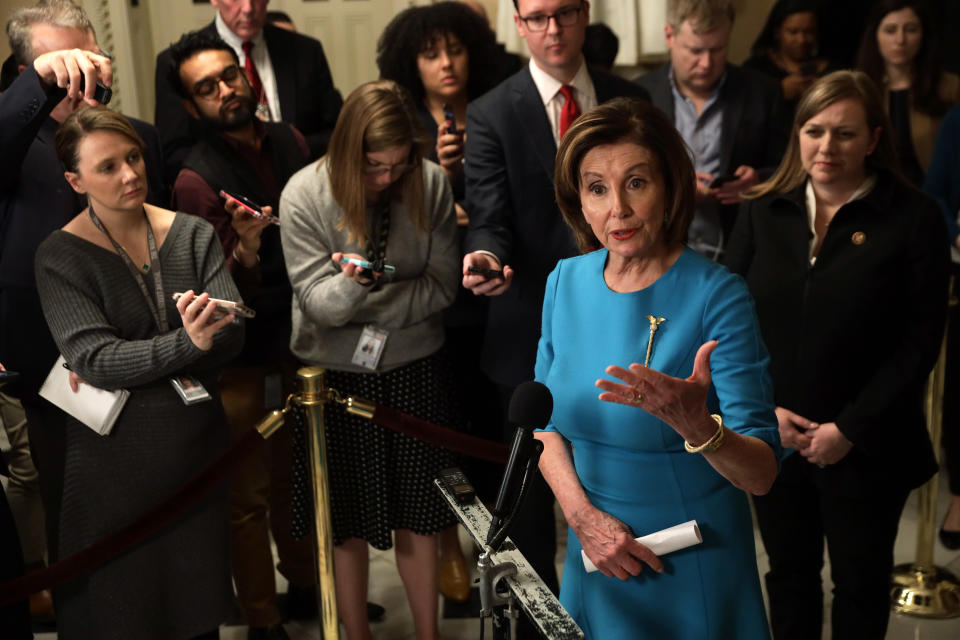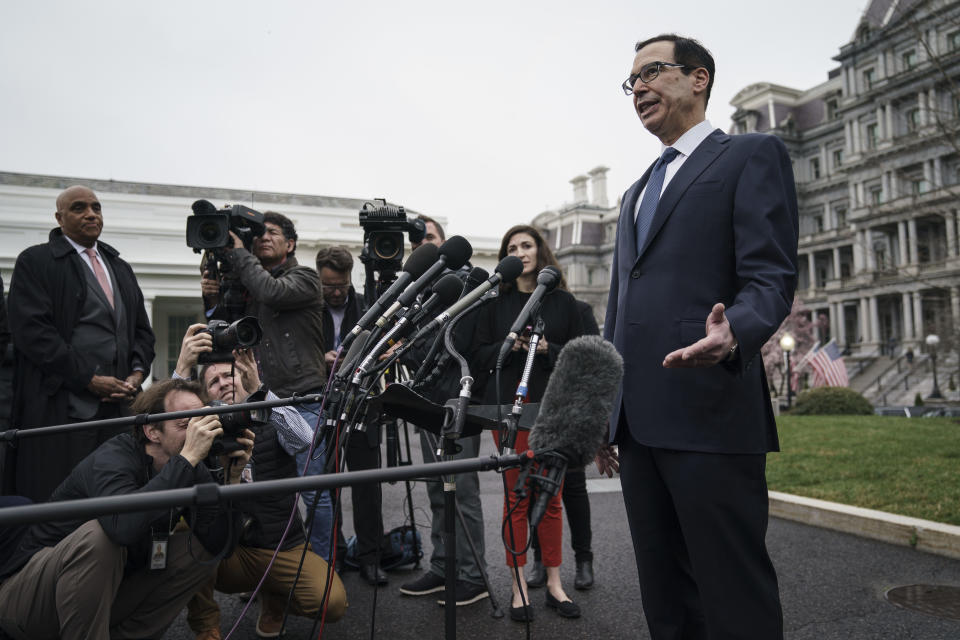Coronavirus response: What’s in Washington’s economic stimulus deal
Early Saturday morning, the House of Representatives pushed through an economic stimulus measure by a vote of 363-40 in response to the new coronavirus outbreak.
The deal between Speaker Nancy Pelosi and the Trump administration is expected to be passed in the Senate next week and then signed by President Donald Trump, who has tweeted his support of the measure. It provides free coronavirus testing for everyone, including the uninsured, as well as job protections for those who are quarantined due to the virus, among other measures.
The bill comes on the heels of an $8.3 billion emergency spending bill passed last week to deal with the coronavirus, or COVID-19, outbreak, which has been declared a pandemic.
“Between these two bills, we have an effective stimulus to the economy,” Pelosi said. Lawmakers are also promising more legislative measures in the weeks and months ahead perhaps to help the airline, hospitality, and entertainment industries.

Trump declared a state of emergency on Friday to mobilize the federal government and funnel $50 billion to states and localities to respond to the crisis.
Here’s what’s in this round of Washington’s legislative response to the crisis and — most importantly — some hints from within the 110-page bill about how soon the measures may have an impact in communities struggling with this crisis.
Free coronavirus testing for everyone, including the uninsured
"The three most important parts of this bill are testing, testing, testing," Pelosi said Friday.
The lack of sufficient testing has been the centerpiece of the political debate and one the most urgent problems. However, it’s unclear how much faster this bill will get people tests who need them given the nationwide shortfall and a range of other ongoing measures to improve access. While the Centers for Disease Control and Prevention (CDC) said Friday that there are 1,689 confirmed cases of coronavirus in the U.S., the numbers are likely higher because of inadequate testing.
“Don’t believe the numbers,” said Johns Hopkins University Professor Dr. Marty Makary said of the testing shortfall during an appearance on Yahoo Finance on Friday. “There are probably 25-50 people who have the virus for every one person who is confirmed.”
The just-passed bill has a range of provisions designed to increase testing.
It says that insurance companies shall not impose any costs on policyholders “beginning on or after the date of the enactment of this Act.” Up until now, only a tiny fraction of the U.S. population has been getting tested.
It also creates a billion-dollar ‘‘Public Health and Social Services Emergency Fund’’ to pay back the costs of testing services to people who lack health insurance.
The measure allocates money to places like Medicare, Medicaid, the Department of Defense, the Indian Health Services, and the Veterans Health Administration to speed up free testing among people who get healthcare through those institutions.
Representative Katie Porter earned widespread acclaim when — through persistent questioning — she got Robert Redfield, the director of the CDC, to say that tests for the coronavirus will be covered by insurance policies.
I did the math: a full battery of coronavirus testing costs at minimum $1,331.
I also did the legal research: the Administration has the authority to make testing free for every American TODAY.
I secured a commitment from a high-level Trump official that they’d actually do it. pic.twitter.com/RmolCtmNbG— Rep. Katie Porter (@RepKatiePorter) March 12, 2020
On a different front, the Trump administration also announced on Friday a series of steps to allow private labs more leeway in order to increase the testing capacity and approval for a private sector test — the Roche cobas SARS-CoV-2 Test — that could make testing 10 times faster.
Through both the bill and the emergency declaration, we “want to make sure that people can get free testing,” said Treasury Secretary Steven Mnuchin on Fox Business night after a deal had been reached. “The president wants lots of testing.”

‘Public health emergency leave’
The bill also provides 14 days of paid sick leave and up to three months of paid family and medical leave in light of the coronavirus outbreak.
It amends the Family and Medical Leave Act of 1993 to give employees the right to take job-protected leave if they need to quarantine, care for a family member, or care for a child at home because their school is closed.
The bill specifies that two weeks shall be paid followed by a provisions for the weeks that could follow where "employees will receive a benefit from their employers that will be no less than two-thirds of the employee’s usual pay."
The bill also allocated $15 million to the Internal Revenue Service to implement tax credits for paid sick and paid family and medical leave.
Pelosi has made paid leave one of her top priorities. In a joint statement last Sunday with Senate Democratic Leader Chuck Schumer, she called for sick leave to alleviate the consequences of lost wages for “workers impacted by quarantine orders or responsible for caring for children impacted by school closures.”
Enhanced unemployment insurance and other measures
The bill also provides a $1 billion for emergency grants to states to help with processing and paying unemployment claims.
Half of that amount will come in “immediate additional funding to all states for staffing” while the remainder will be held for emergency grants that will then be focused on states that experience a 10% increase in unemployment.
There is also over $1 billion allocated to strengthened food security initiatives. The relief is focused on senior citizens, low-income Americans, low-income pregnant women and mothers with young children, students, as well as all recipients of the Supplemental Nutrition Assistance Program (SNAP).
What’s not in the bill: a payroll tax cut
The key omission is a payroll tax cut, which the Trump administration has been focused on all week. Just hours before the deal was finalized, President Trump tweeted “Only that will make a big difference!”
If you want to get money into the hands of people quickly & efficiently, let them have the full money that they earned, APPROVE A PAYROLL TAX CUT until the end of the year, December 31. Then you are doing something that is really meaningful. Only that will make a big difference!
— Donald J. Trump (@realDonaldTrump) March 13, 2020
The only mention of the payroll tax in the final bill is in the context of a credit for required paid sick and paid family leave.
As Greg Valliere, the chief U.S. policy strategist at AGF Investments, noted before the deal was finalized but after the major provisions were clear “It will be Pelosi’s bill, not Trump’s.”
The administration is likely to continue pushing for a payroll tax cut in the coming weeks but the idea has been a nonstarter among Democrats.
As of Saturday morning, the President was publicly happy with the deal. “Good teamwork between Republicans & Democrats,” he tweeted “People really pulled together. Nice to see!”
Ben Werschkul is a producer for Yahoo Finance in Washington, DC.
Read more:
Trump declares national coronavirus emergency as worldwide deaths top 5000
Why Democrats are ‘lukewarm’ on the idea of a payroll tax cut
Breaking down the $8.3 billion emergency spending bill Trump signed
Read the latest financial and business news from Yahoo Finance
Follow Yahoo Finance on Twitter, Facebook, Instagram, Flipboard, LinkedIn, YouTube, and reddit.

